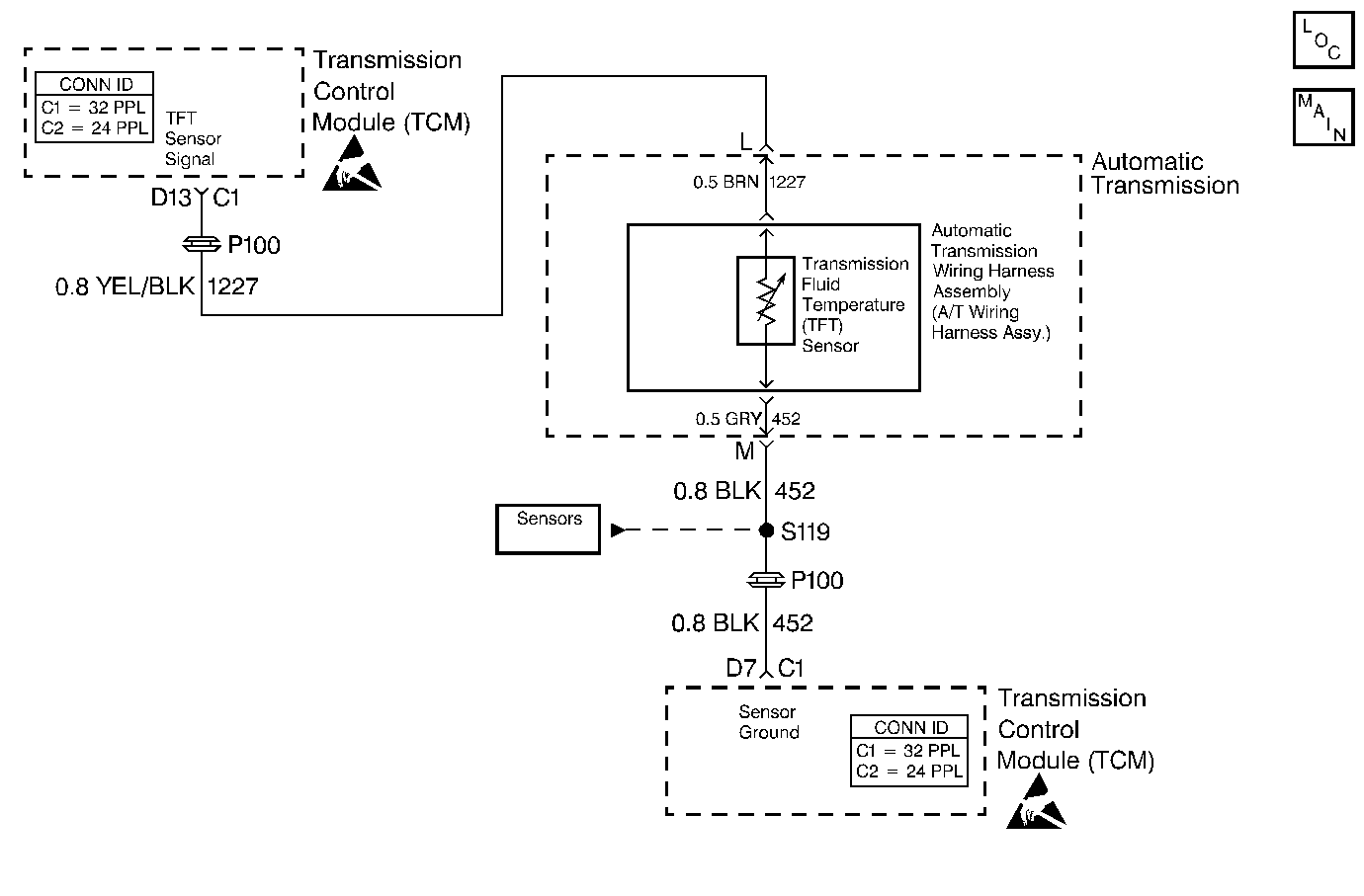DTC 59 TFT Sensor Circuit High L57 MFI

Circuit Description
The automatic transmission fluid temperature (TFT) sensor is a thermistor that controls the signal voltage to the transmission control module (TCM). The TCM supplies a 5 volt reference signal to the sensor on circuit 1227. When the transmission fluid is cold, the sensor resistance is high and the controller senses high signal voltage.
As the transmission fluid temperature warms to normal transmission operating temperature, the sensor resistance becomes less and the voltage decreases. With a DTC 79 also set, check the transmission cooling system.
If the TCM detects a continuous short to ground in the TFT signal circuit, then DTC 59 sets.
Conditions for Running the DTC
| • | The ignition is ON. |
| • | System voltage is 12.0-16.0 volts. |
Conditions for Setting the DTC
| • | Signal voltage indicates TFT less than -40°C (-40°F). |
| • | All conditions met for 1 second. |
Action Taken When the DTC Sets
| • | The TCM does not illuminate the malfunction indicator lamp MIL. |
| • | The TCM defaults to 140°C for a transmission fluid temperature (causing a hot mode shift pattern to occur). |
| • | The TCM stores DTC 59 in TCM history. |
Conditions for Clearing the DTC
| • | A scan tool clears the DTC from TCM history. |
| • | The TCM clears the DTC from TCM history if the vehicle completes 40 consecutive key cycles without a diagnostic fault occurring. |
| • | The TCM cancels the DTC default actions when the fault no longer exists and the ignition switch is OFF long enough in order to power down the TCM. |
Diagnostic Aids
| • | Inspect the wiring at the TCM, the transmission connector and all other circuit connecting points for the following conditions: |
| - | A backed out terminal |
| - | A damaged terminal |
| - | Reduced terminal tension |
| - | A chafed wire |
| - | A broken wire inside the insulation |
| - | Moisture intrusion |
| - | Corrosion |
| - | Higher than normal voltage in circuit 1227 may also damage the TFT Sensor. |
| • | When diagnosing for an intermittent short or open, massage the wiring harness while watching the test equipment for a change. |
| • | The scan tool displays the transmission fluid temperature in degrees. After the transmission operates, the temperature rises steadily. The temperature then stabilizes. |
| • | Test the TFT sensor at the various temperatures in order to evaluate the possibility of a skewed (mis-scaled) sensor. Refer to the Temperature vs Resistance table. A skewed sensor may cause firm shifts or TCC complaints, extended shift patterns, and early TCC applies to occur. |
| • | First, diagnose and clear any engine DTCs that are present. Then inspect for any transmission DTCs that may have reset. |
Test Description
The numbers below refer to the step numbers on the diagnostic table.
-
This step tests for higher than normal circuit voltage, which may also damage the TFT sensor.
-
This step simulates a TFT sensor DTC 58. If the TCM recognizes the low signal voltage (high temperature), and the Scan Tool displays 146°C (295°F) or greater, the TCM and the wiring are OK.
-
This step verifies a condition in the TFT sensor circuit.
-
This step inspects the TFT sensor and the A/T wiring harness assembly.
Step | Action | Value(s) | Yes | No |
|---|---|---|---|---|
1 | Was the Powertrain On-Board Diagnostic (OBD) System Check performed? | -- | ||
2 | Perform the Transmission Fluid Checking Procedure. Refer to Transmission Fluid Check . Was the Transmission Fluid Checking Procedure performed? | -- | Go to Transmission Fluid Check | |
3 |
Important:: Before clearing the DTCs, use the scan tool in order to record the Failure Records. Using the Clear Info function erases the Failure Records from the TCM. Does the Scan Tool display a transmission fluid temperature less than the specified value? | -30°C (-22°F) | Go to Diagnostic Aids | |
4 |
Is the voltage within the specified value? | 4.9-5.0 volts | ||
Is the J 39200 DMM voltage greater than the specified value? | 5.1 volts | |||
Is the transmission fluid temperature greater than the specified value? | 140°C (284°F) | |||
Is the resistance within the specified values? | 16 kohms at 10°C (50°F) to 133 kohms at 110°C (230°F) | Go to Diagnostic Aids | ||
Refer to Automatic Transmission Fluid and Filter Replacement . Was a condition found? | -- | Go to Diagnostic Aids | ||
9 | Replace the A/T wiring harness assembly. Refer to A/T Wiring Harness Assembly Replacement. Is the replacement complete? | -- | ||
10 | Inspect the engine harness circuit 1227 (YEL/BLK) for high resistance or an open. Refer to General Electrical Diagnosis in Wiring Systems. Was a condition found? | -- | ||
11 | Inspect engine harness circuit 1227 (YEL/BLK) for a short to voltage B+. Refer to General Electrical Diagnosis in Wiring Systems. Was a condition found? | -- | ||
12 | Inspect engine harness circuit 452 (BLK) for an open. Refer to General Electrical Diagnosis in Wiring Systems. Was a condition found? | -- | ||
13 | Repair the wiring as necessary. Refer to Wiring Repairs in Wiring Systems. Is the repair complete? | -- | -- | |
14 | Replace the TCM. Refer to Powertrain Control Module Replacement/Programming in Engine Controls. Is the replacement complete? | -- | -- | |
15 | Perform the following procedure in order to verify the repair:
Is the transmission fluid temperature greater than -40°C (-40°F). | -- | System OK |
